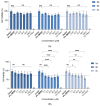Click on Click: Click-Flavone Glycosides Encapsulated in Click-Functionalised Polymersomes for Glioblastoma Therapy
- PMID: 40574083
- PMCID: PMC12196103
- DOI: 10.3390/pharmaceutics17060771
Click on Click: Click-Flavone Glycosides Encapsulated in Click-Functionalised Polymersomes for Glioblastoma Therapy
Abstract
In this study, three new 3,7-dihydroxyflavone (1) derivatives with different sugars were designed and synthesised by click chemistry. Click chemistry requires the previously modification of building blocks with azide and alkyne groups and therefore, the 3,7-dihydroxyflavone (1) was first converted in 3,7-(prop-2-yn-yloxy)flavone (2) and acetobromo-α-D-glucose (3) was converted into 2,3,4,6-tetra-O-acetyl-β-glucopyranosyl azide (4). Subsequently, a click reaction was performed via copper-catalysed cycloaddition (CuAAC) between 2 and 4, as well as between 2 and 2-acetamido-3,4,6-tetra-O-acetyl-2-deoxy-β-D-glucopyranosyl (AG931) and, 2 and commercial 2-azidoethyl 2,3,4,6-tetra-O-acetyl-β-D-glucopyranosyl (AG358), resulting in three distinct disubstituted flavone glycosides (5a-5c). Biological assays performed on L929 fibroblast cell lines and human glioblastoma astrocytoma U-251 cell lines indicated cytocompatibility with fibroblasts and reduced metabolic activity of GBM cells in the presence of compound 5b and 5c. To enhance therapeutic effect, improve local drug delivery, and overcome solubility issues of these high molecular weight compounds, the synthesised compounds were encapsulated in polymeric particles (polymersomes, PMs) composed of polylactic acid-polyethylene glycol (PEG-PLA) functionalized, once more by click chemistry, with 0.1 mol% transferrin mimetic (T7-HRPYIAH) peptide. The PMs were prepared by solvent displacement and exhibited stability over 100 days, encapsulation efficiency of 39-93%, and mean size diameters of 120-180 nm. The toxicity assays of the PMs on the U-251 cell line showed a significant decrease in metabolic activity, supporting the potential of this delivery system against GBM. Among the PMs tested, the flavone 5c-based PM demonstrated the highest efficacy.
Keywords: click chemistry; drug delivery; flavones; glioblastoma; polymersome.
Conflict of interest statement
The authors declare no conflicts of interest.
Figures








Similar articles
-
Sequential versus standard triple first-line therapy for Helicobacter pylori eradication.Cochrane Database Syst Rev. 2016 Jun 28;2016(6):CD009034. doi: 10.1002/14651858.CD009034.pub2. Cochrane Database Syst Rev. 2016. PMID: 27351542 Free PMC article.
-
Systemic pharmacological treatments for chronic plaque psoriasis: a network meta-analysis.Cochrane Database Syst Rev. 2017 Dec 22;12(12):CD011535. doi: 10.1002/14651858.CD011535.pub2. Cochrane Database Syst Rev. 2017. Update in: Cochrane Database Syst Rev. 2020 Jan 9;1:CD011535. doi: 10.1002/14651858.CD011535.pub3. PMID: 29271481 Free PMC article. Updated.
-
Systemic pharmacological treatments for chronic plaque psoriasis: a network meta-analysis.Cochrane Database Syst Rev. 2021 Apr 19;4(4):CD011535. doi: 10.1002/14651858.CD011535.pub4. Cochrane Database Syst Rev. 2021. Update in: Cochrane Database Syst Rev. 2022 May 23;5:CD011535. doi: 10.1002/14651858.CD011535.pub5. PMID: 33871055 Free PMC article. Updated.
-
Non-contraceptive oestrogen-containing preparations for controlling symptoms of premenstrual syndrome.Cochrane Database Syst Rev. 2017 Mar 3;3(3):CD010503. doi: 10.1002/14651858.CD010503.pub2. Cochrane Database Syst Rev. 2017. PMID: 28257559 Free PMC article.
-
Adefovir dipivoxil and pegylated interferon alfa-2a for the treatment of chronic hepatitis B: a systematic review and economic evaluation.Health Technol Assess. 2006 Aug;10(28):iii-iv, xi-xiv, 1-183. doi: 10.3310/hta10280. Health Technol Assess. 2006. PMID: 16904047
References
-
- Esiri M.M., Oppenheimer D.R. Oppenheimer’s Diagnostic Neuropathology: A Practical Manual. 3rd ed. Volume 33 Blackwell Scientific Publications; Oxford, UK: 2007.
-
- Morais L.C., Queiroz V.C.J., Cavalcante J.E.S., Matozinho H.H.S., Silva F.H.R., Costa M.G.P., Pereira I F.Y., Tavares L.C.P., Guimarães G.M. Treatment and Prognosis of Glioblastoma Multiforme: A Literature Review. J. Neurol. Sci. 2015;357:e183. doi: 10.1016/j.jns.2015.08.630. - DOI
LinkOut - more resources
Full Text Sources

